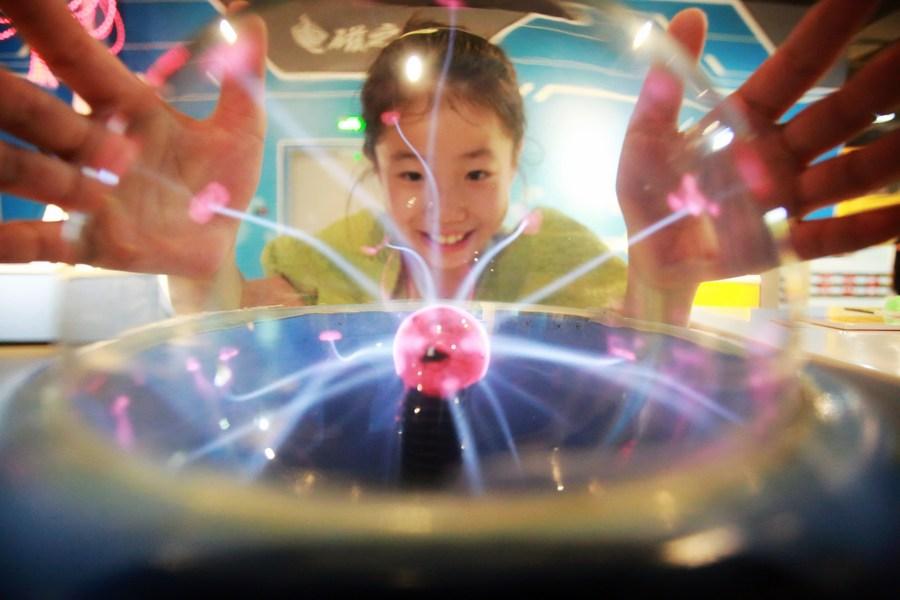

A child interacts with a plasma globe at Yangzhou Science and Technology Museum in Yangzhou, East China's Jiangsu
For Liu Ziqi, an eight-year-old museum lover in Beijing, this winter vacation has proved a rather busy one, as she made a to-go list for newly opened exhibitions in the Chinese capital.
During the seven-day Spring Festival holiday starting from Jan. 21, museums in Beijing received 1.01 million visits, up 34 percent year on year, according to Beijing Municipal Cultural Heritage Bureau.
Like Liu, more and more young people, some not necessarily big fans of museums, chose to spend some of their leisure time in a museum.
Collaboration
"There are more special exhibitions and more joint exhibitions, especially the one between the National Museum and the Palace Museum," Liu said, when asked about the most notable change during her latest museum visit.
The exhibition that Liu refers to is "Harmonious Co-existence," the first exhibition held jointly by the two museums in recent years. Featuring over 400 exhibits, from picture scrolls depicting ancient Chinese legends to copies of philosophical classics, it elaborates on the historical origins of the concepts of "harmony" and "unity," which are rooted in the Chinese culture.
"Eye-opening. It truly was a powerful collaboration between the two," said a netizen on the microblogging site Weibo. "I kind of realized what the exhibition is all about after seeing the last two showcases."
"Joint exhibitions, itinerant exhibitions and mutual exhibitions can counter geographical and spacial limitations and revitalize relics," said Yan Hongming, chairman of the Zhejiang Museum Association.
Collaborations between museums and arts organizations also help the younger generation get closer to the relics by reliving the stories behind them.
Last November, a music-and-dance performing group recreated the feminine beauty and social customs of the Tang Dynasty (618-907) by delivering a portrayal on stage of "Ladies Wearing Flowers in Their Hair," a painting kept in the Liaoning Provincial Museum, northeast China.
The museums are innovating their forms to attract more people. "Luduan," a children's musical named after a unicorn in Chinese mythology, is a production of the Palace Museum and it was staged at the National Center for the Performing Arts last week. The images of "Luduan" can be found in many places in the Palace museum.
Interaction
A professional museum narrator for over 10 years, Bai Xuesong at Xi'an Beilin Museum, northwest China's Shaanxi Province, observed that more visitors are expecting specialized introductions to the ins and outs behind the cultural relics.
"Beilin," which means forest of stone steles in Chinese, is a must-visit for calligraphy and history lovers. In China, many calligraphy masterpieces of great calligraphists were carved on stone steles.
"More and more visitors began asking questions, and sometimes we couldn't give an answer," Bai said, adding that this indicates a change in the relationship between narrators and visitors -- from "teaching" to interactive communication and mutual learning.
New technologies including AI and VR also enabled museums in China to make a shift from purely displaying artifacts to actively engaging with visitors.
Liu Tingting, a young museum-goer, was thrilled to experience how technologies took her back to the glorious Tang Dynasty at the Daming Palace Heritage Museum.
"I saw the pottery roof decorations for the Tang Dynasty palace, and also learned how they were installed by watching digital projections. I saw female attendant figurines, and tried on their makeup on the screen as well," said Liu after visiting the museum in Xi'an. "It feels like traveling back to the Tang Dynasty. Now I feel closer to history."
Tailoring multiple interactive and educational activities for the kids, the Beijing Auto Museum also became a must-visit destination for young museum lovers. Over 50,000 visits were made to the museum from Jan. 21 to Feb. 5, the Lantern Festival.
Shift in demand
According to data from the National Administration of Cultural Heritage (NCHA), the number of museums in China had reached 6,183 by the end of 2022, over twice as many as in 2012. In 2021 alone, 395 new museums were added to the administration's records.
"For the public, intellectual and cultural activities are gradually becoming inseparable necessities of their lives," said Jin Jiangbo, vice president of the Shanghai Academy of Fine Arts, Shanghai University, explaining reasons behind this boom in museums.
According to a guideline issued by the NCHA and eight other departments in 2021, efforts were to be made to integrate museums with industries including education, science and technology, tourism, and commerce.
Such integrations are transforming museums from mere places of public culture and education to public service complexes, meeting the needs of the younger generation who want diversified cultural experiences.
According to data from online travel agency Trip.com Group, formerly known as Ctrip, in the first half of 2022, the majority of users who booked museum tickets through its platform were born in the 1980s and 1990s, and those born between 1995 and 2000 accounted for nearly 30 percent of museum related searches.
